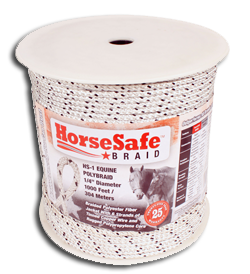Electric fences are designed to minimize injuries to horses and livestock.
Equally important, you must provide correct installation and proper maintenance.
A collision with a rigid fence is the most frequent cause of serious horse injury. It is important to choose an electric fence that is not rigid, but resilient, like a boxing ring. When a horse at full gallop impacts an electric fence, it should bounces right back, with no damage to horse or fence.
Electric fencing is a psychological barrier. We advise our customers to always maintain at least 5,000 volts and good electrical grounding to ensure their horses receive a significant electric shock – – not just a “bee-sting”. A shock from an approved electric fence energizer is not harmful because the shock is low amperage for a tiny fraction of a second (similar in duration to a static shock from your TV set). A UL or CSA approved energizer won’t harm a two year old child or new born foal.
You can buy and install a fence minder which will continuously monitor your fence. It will warn you day or night if it detects a significant voltage drop. If a horse is in contact with your fence for more than 3 seconds, a fence minder will turn off your energizer to stop further shocks; and immediately alert you by siren or by auto-dialing your choice of telephone numbers.
If properly installed, electric fence injuries with are very rare. If an incident occurs, please call 1-419-836-9048 so we can discuss the circumstances with you. Hopefully, we can together take corrective action to prevent any future injury.
Provided you verify your fence is properly grounded, and regularly check your voltage with a voltmeter, your fence minder will give you the peace of mind of knowing that your electric fence is keeping your horses safe.
Do’s & Don’ts – Electric Fence Safety and Maintenance
To keep your horses safe, use good horse sense:
- Know your horses and recognize the limitations of your property.
- Separate aggressive stallions from other horses by a lane-way.
- Always introduce a horse to a new pasture. For your own safety, turn OFF the fence energizer so the horse you are leading won’t get accidentally shocked and bolt. Lead the horse around the fence perimeter. Once the horse understands the boundaries of its new pasture, release the horse and turn the energizer back ON.
- Take particular care when you introduce a new horse to a pasture where other horses have an established pecking order.
- Don’t torment your horses with accidental electric shocks by putting water troughs close to your electric fence, hanging grain pails on your fence posts, or throwing hay near your electric fence.
- Don’t build a new fence close to where your horses roll. If necessary, relocate the fence away from where they habitually roll.
- Small paddocks can be hazardous to very active horses. They need room to roll.
Fence Sense:
- Install your electric fence as recommended. Set the highest strand at 48 to 54 inches and the lowest strand at 18 to 26 inches.
- Don’t turn off your fence energizer to save electricity. The cost of electricity for a fence energizer is the same as a 100-watt light bulb – about a dollar a month.
- Regularly inspect your fence to ensure the braid is taut and properly electrified.
- Thoroughly check the fence after heavy rain or stormy weather.
- Take particular care to make sure your fence is well grounded. 95% of all electric fence problems are due to poor grounding. Check your installation manual or our website, or call us for advice.
- Use a hot-cold system – ground the second-from-the-top-strand of braid.
- Always turn the energizer off before servicing the fence.
- When testing an electric fence with a voltmeter, wear rubber gloves or rubber-soled shoes to minimize any accidental electrical shock. Wet or sweaty hands or wet feet intensify electrical shocks.
- Use only one energizer per paddock or continuous fence line. Never use two energizers on the same fence.
- Use extreme caution if you are considering installing an electric fence near overhead lines or underground power lines.
- Do not stand beside a fence during an electrical storm.
- Use warning signs to mark an electric fence every 200-300 feet.
- Never attempt to service your energizer. If it fails, seek professional assistance or send to the manufacturer for servicing.
- Most electric fences are engineered for your horses’ safety. Don’t take shortcuts!
- Please manage your horses with care and maintain your fences. Courts hold the property owner responsible for the security of their animals.
Do not …
- Hang feed buckets on the fence;
- Drape water hoses over the fence;
- Stack feed or manure near the fence;
- Run water lines parallel to the fence;
- Allow feed or water barrels to be located too close to the fence.
Our Company Mission is To Provide Safe Fences for your animals.
Our Friendly Staff is ALWAYS Here To Help.
Any Questions? Call us at 1-419-836-9048


